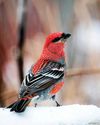Intentar ORO - Gratis
Busy Bees
Birds & Blooms
|February/March 2022
Fuzzy, gentle and efficient, mason bees are champion pollinators. Here's why you want to attract them to your garden.

More than 150 species make up a group of native bees called mason bees, which handled pollination here long before European honeybees arrived.
“Solitary bees such as mason bees are perfectly adapted for great pollination,” says Matthew Shepherd, director of outreach and education for the Xerces Society for Invertebrate Conservation.
Unlike honeybees that gather pollen in packages on their hind legs, mason bees belly-flop into blossoms, and the pollen clings to the hairs on their bodies. As a result, they can pollinate up to 2,000 flowers per day, according to Thyra McKelvie of Rent Mason Bees in Bothell, Washington. She also notes that each mason bee can do the work of 100 honeybees. And because they're well-adapted to the climate, they fly in cooler temperatures and brave drizzly conditions.
Gentle Gardeners
The busy fliers are valuable in home gardens because they pollinate an array of early-blooming plants. Plus, they're easy to raise and fun to watch.
Esta historia es de la edición February/March 2022 de Birds & Blooms.
Suscríbete a Magzter GOLD para acceder a miles de historias premium seleccionadas y a más de 9000 revistas y periódicos.
¿Ya eres suscriptor? Iniciar sesión
MÁS HISTORIAS DE Birds & Blooms

Birds & Blooms
Ready to Fly
For birders, spring migration is something to look forward to and be celebrated, but how do birds know when it's time to begin their travels?
2 mins
December 2025 / January 2026

Birds & Blooms
COOL AS A Camellia
When temperatures drop, most plants wait out the chilly months, but camellias put on a show. Discover how to have these beauties thriving in your yard.
2 mins
December 2025 / January 2026

Birds & Blooms
Festive Feathers
Readers braved the winter chill to capture these snowy snapshots of the season's most beautiful birds
2 mins
December 2025 / January 2026

Birds & Blooms
Winter Gems
With raspberry-red feathers, pine grosbeaks cheer up chilly landscapes wherever they land
2 mins
December 2025 / January 2026

Birds & Blooms
the mysterious lives of NIGHTHAWKS
These creatures of contradiction aren't hawks and aren't the most active at night, but they are worth knowing
3 mins
December 2025 / January 2026

Birds & Blooms
Adventure Awaits
Pack your bags, get on board and find your next vacation destination in these captivating photos from far-flung travels
2 mins
December 2025 / January 2026

Birds & Blooms
It's All in the Needles
Get to know the greenery to identify these conifers
1 min
December 2025 / January 2026

Birds & Blooms
Christmas Tree Do's and Don'ts
These pro tips will help you get the most out of this classic holiday fixture
2 mins
December 2025 / January 2026

Birds & Blooms
Trailing Houseplants
Simple, easy-to-grow plants for hanging containers
3 mins
December 2025 / January 2026

Birds & Blooms
Better Off with Bats
Rethink the unsung heroes of the night and why you should support them
2 mins
October / November 2025
Translate
Change font size

